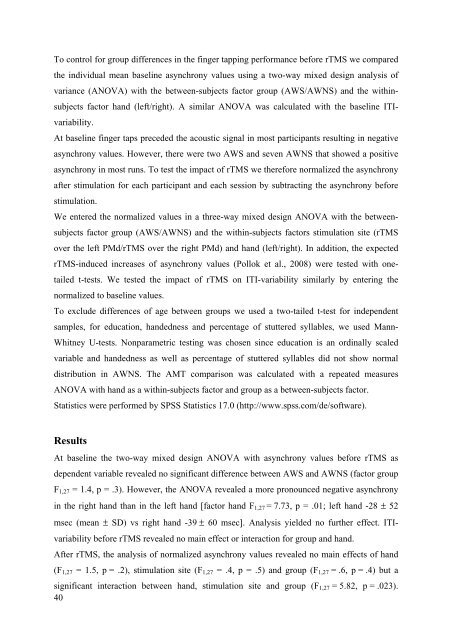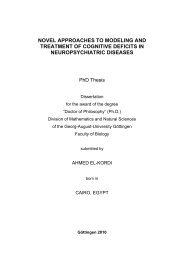Cortical and subcortical mechanisms in persistent stuttering ...
Cortical and subcortical mechanisms in persistent stuttering ...
Cortical and subcortical mechanisms in persistent stuttering ...
Create successful ePaper yourself
Turn your PDF publications into a flip-book with our unique Google optimized e-Paper software.
To control for group differences <strong>in</strong> the f<strong>in</strong>ger tapp<strong>in</strong>g performance before rTMS we compared<br />
the <strong>in</strong>dividual mean basel<strong>in</strong>e asynchrony values us<strong>in</strong>g a two-way mixed design analysis of<br />
variance (ANOVA) with the between-subjects factor group (AWS/AWNS) <strong>and</strong> the with<strong>in</strong>-<br />
subjects factor h<strong>and</strong> (left/right). A similar ANOVA was calculated with the basel<strong>in</strong>e ITIvariability.<br />
At basel<strong>in</strong>e f<strong>in</strong>ger taps preceded the acoustic signal <strong>in</strong> most participants result<strong>in</strong>g <strong>in</strong> negative<br />
asynchrony values. However, there were two AWS <strong>and</strong> seven AWNS that showed a positive<br />
asynchrony <strong>in</strong> most runs. To test the impact of rTMS we therefore normalized the asynchrony<br />
after stimulation for each participant <strong>and</strong> each session by subtract<strong>in</strong>g the asynchrony before<br />
stimulation.<br />
We entered the normalized values <strong>in</strong> a three-way mixed design ANOVA with the betweensubjects<br />
factor group (AWS/AWNS) <strong>and</strong> the with<strong>in</strong>-subjects factors stimulation site (rTMS<br />
over the left PMd/rTMS over the right PMd) <strong>and</strong> h<strong>and</strong> (left/right). In addition, the expected<br />
rTMS-<strong>in</strong>duced <strong>in</strong>creases of asynchrony values (Pollok et al., 2008) were tested with onetailed<br />
t-tests. We tested the impact of rTMS on ITI-variability similarly by enter<strong>in</strong>g the<br />
normalized to basel<strong>in</strong>e values.<br />
To exclude differences of age between groups we used a two-tailed t-test for <strong>in</strong>dependent<br />
samples, for education, h<strong>and</strong>edness <strong>and</strong> percentage of stuttered syllables, we used Mann-<br />
Whitney U-tests. Nonparametric test<strong>in</strong>g was chosen s<strong>in</strong>ce education is an ord<strong>in</strong>ally scaled<br />
variable <strong>and</strong> h<strong>and</strong>edness as well as percentage of stuttered syllables did not show normal<br />
distribution <strong>in</strong> AWNS. The AMT comparison was calculated with a repeated measures<br />
ANOVA with h<strong>and</strong> as a with<strong>in</strong>-subjects factor <strong>and</strong> group as a between-subjects factor.<br />
Statistics were performed by SPSS Statistics 17.0 (http://www.spss.com/de/software).<br />
Results<br />
At basel<strong>in</strong>e the two-way mixed design ANOVA with asynchrony values before rTMS as<br />
dependent variable revealed no significant difference between AWS <strong>and</strong> AWNS (factor group<br />
F1,27 = 1.4, p = .3). However, the ANOVA revealed a more pronounced negative asynchrony<br />
<strong>in</strong> the right h<strong>and</strong> than <strong>in</strong> the left h<strong>and</strong> [factor h<strong>and</strong> F1,27 = 7.73, p = .01; left h<strong>and</strong> -28 ± 52<br />
msec (mean ± SD) vs right h<strong>and</strong> -39 ± 60 msec]. Analysis yielded no further effect. ITI-<br />
variability before rTMS revealed no ma<strong>in</strong> effect or <strong>in</strong>teraction for group <strong>and</strong> h<strong>and</strong>.<br />
After rTMS, the analysis of normalized asynchrony values revealed no ma<strong>in</strong> effects of h<strong>and</strong><br />
(F1,27 = 1.5, p = .2), stimulation site (F1,27 = .4, p = .5) <strong>and</strong> group (F1,27 = .6, p = .4) but a<br />
significant <strong>in</strong>teraction between h<strong>and</strong>, stimulation site <strong>and</strong> group (F1,27 = 5.82, p = .023).<br />
40



